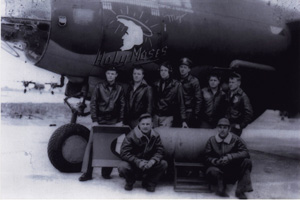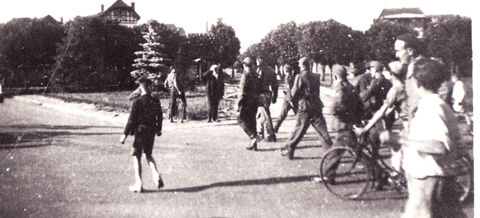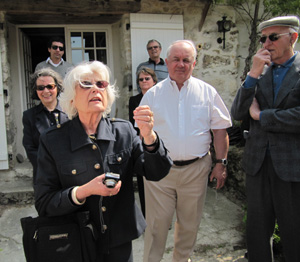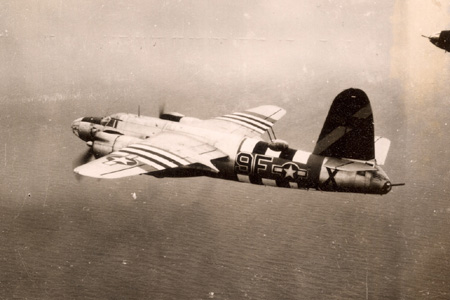|
Home
Historical Research POW
Evasion
Reports
Bombing of the Sartrouville/Maisons-Laffitte
railway bridge
Context
|
The railway linking Paris to Normandy was obviously
of vital strategic importance for the German
logistics in the perspective of the June 6, 1944 allied
landing. This railway crosses the Seine on a bridge
linking Sartrouville on the right side and
Maisons-Laffitte on the left side. This bridge was a
primary target in the bombing campaign preceding
D-Day.
The bridge is located in the middle of an urban area
and the underground was worried a bombing raid would
mean heavy civilian casualties. According to
Bernard Morinais (a local resistant who turned 20 on
June 6, 1944), the underground contacted the allies
in London and offered to destroy the bridge. The
allies declined the offer, fearing that German
retaliation on the civilian population would entail
more civilian casualties than an allied led bombing.
A first bombing raid took place on Saturday May 27,
1944 around 1400. The bridge was missed. Several
bombs fell on the city killing approximately 200
people. A second raid took place the next day, May
28, 1944 around 10.00 again missing the target.
Seven more raids followed during the day. A total of
9 bombing raids took place over a 30 hour period,
leaving the population in a state of shock.
(Source:
Bernard Morinais)
|
|
Larger
Map
|
The bridge was finally sufficiently damaged to
disrupt railway traffic and the Germans started the
repair work on Tuesday, May 30 1944 using Russian
slave workers. The Germans also added more flak
around the bridge.
(Source:
Bernard Morinais)
The June 24, 1944 bombing
Four weeks later the bridge was rebuilt and the
underground informed London that a fully loaded
train was scheduled to cross the bridge on June 24
at 1900 in order to test the repairs. The allies
therefore decided to schedule the bombing at
precisely 1900 hoping to destroy both the bridge and
the train…
(Source:
Bernard Morinais)
The mission was assigned to the 397th BG
based in Rivenhall, England.
The evening before the bombing, co-pilot Ossian
Seipel got the information he would take part in a
bombing raid on Paris and he got the strange feeling
he would not come back. So much so that he decided
to burn his letters and give away some of his
belongings.
(Source:
Seipel's Memoirs)
Pilot Freal Knox later said to his son
that he also had a bad feeling after being briefed
about the mission. The reason being that this target
had been previously bombed several times thus
providing extensive “training” to the German flak.
The June 24 raid would follow exactly the same
approach and bomb run as the May 27 and May 28
attacks and the Germans would know exactly how to
align their artillery. He also knew that German flak
would have been reinforced since the previous raids.
On June 24, 1944 at 17.18, 39 B-26 bombers took off
from Rivenhall, England. Thirty-six were loaded with
two 2,000 pound bombs each. The 3 other B-26 were
flying ahead and dropped bundles of aluminium foil
meant to saturate the German radars.
(Source:
Richard Haymond)
Shortly before 19.00, three French patriots with
shovels on their shoulders and wearing the uniforms
of French railways quietly walked towards a flak
unit located near the railway. They slaughtered the
two Germans operation the flak with their shovels…
(Source:
Bernard Morinais)
The sky was cloudless and while approaching the
target, the airmen could clearly see the little dark
clouds of the flak. Aircraft
42-96127
received a
direct hit and crashed immediately
avenue de la Fontaine in Maisons-Laffitte
killing all six
men on board. These 6 men paid the high price for
our freedom and should be remembered:
S/Sgt James M Crawford, S/N: 37506385
S/Sgt Scott E. Hoover, S/N: 33291544
2Lt Edward M Lindquist, S/N: O-746663
2Lt Samuel C Neill, S/N: O-687700
2Lt Olivier A. Price, S/N: O-816574
S/Sgt Harold G Vorhees, S/N: 13011177
The 35 remaining B-26 dropped their bombs from an
altitude of 9,000 feet. A total of 70 bombs fell on
and around the target over a very short period of
time... The bridge was hit three times rendering
train traffic impossible. However train traffic
resumed the next day on Sunday 25.
(Source:
letter from the Mayor of Maisons Laffitte)
Two aircrafts crash in the Paris area
Two other B-26 Marauder were hit by flak during the bomb run:
42-96120
and
42-96121. They were both seen burning in
the sky by locals in Aubergenville, 14 miles west of
the target.
|
Aircraft S/N 42-96120 (named "Mama
Liz") crashed in Goupillères
near Flexanville. Pilot Moses J. Gatewood
ordered his crew to bail out shortly before
the crash. The five men jumped from an
altitude of 3,000 feet. While in mid-air,
co-pilot
Richard Haymond noticed that the Germans
were shooting at them. They were made
prisoner shortly after touching ground: 1Lt
Walter Delmont Blatchford (S/N: O-743752),
1Lt Richard Haymond (O-812258), S/Sgt Lee
Hughes (36382232), William Thomas O’Brien
(S/N: 6148980) and William James Snyder
(S/N: 32384117)
Pilot
Moses Gatewood
exited the aircraft from the nose wheels
door and landed in an apple orchard. He
bailed out from a very low altitude. His
descent was therefore very short and thank
to the particular topography of the area,
the Germans didn’t notice him. Helped by the
underground, he managed to reach Spain and
was back in London on August 17. His journey
to the Spanish border is a rather incredible
and fascinating story. Helped by an Alsatian
patriot who had infiltrated the Gestapo,
he drove several hundred kilometres under
German escort and slept in German hotels.
Full story available here.
Important
note: This crew was usually flying the "Holy
Moses". However on that particular day, they
were flying another aircraft: the "Mama
Liz".
|
|

Standing, left to right: Pilot - Moses J.
Gatewood, Radio/Gunner - William T. O'Brien,
Bombardier/Navigator - Walter D. Blatchford,
Co-Pilot - Richard Haymond, Engineer/Gunner
- William J. Snyder, Armourer/Gunner - Eldon
Lee Hughes. Kneeling, Left to Right: Crew
Chief - John Kilmen, Assistant Crew Chief -Virgle
C. Gilbertson - Photo from
William T. O'Brien collection via Sally
Root/Brian Gibbons
|
|
Aircraft S/N 42-96121 crashed in Arnouville-les-Mantes.
James Weldon Mellody was the first to
bail out. He landed in a tree near
Elisabethville-Aubergenville railway
station. The tree was immediately surrounded
by 6 German Wehrmacht soldiers and a swarm
of supportive French civilians who had come
to greet him. The French even offered him a
glass of wine and walked
along with him as he was taken by the Nazis
to the Standortkommandantur.
Details here.
Ossian
Arthur Seipel was the next to bail out and
he landed in a field at the intersection of
highway N13 and the railway going towards
Versailles. He was immediately arrested by
the SS and taken to the German garrison in
the castle of Elisabethville for
interrogation. While on his way to the
German garrison, a French civilian made a V
sign to him. The SS stopped their trucks and arrested him. It is
suspected the man could be
Edouard Jumantier who died in
deportation in March 1945.
|
|

Sgt James Mellody saluted by
Robert Mourand shortly after being arrested
by the Wehrmacht.
See details about this
amazing photo |
William E. Giffhorn bailed out nearly at the
same time as Seipel. However, he opened his
chute earlier and the wind pushed him
towards a wooded area while he was watching Seipel
landing a field.
He was helped by a French couple (Lucienne
Laprêté and Nestor Lambin) who hid him for the night
in their pig pen. When the Germans later came to
search the place, Lucienne told them she had seen an
airman landing further down the road. Deterred by
the smell of the pigs, the Germans didn't want to
investigate any further and proceeded in the
direction she had indicated (Source:
Marianne Heloin Vanura). Giffhorn was then
hidden in Arnouville by underground chief Paufique
till the liberation of the region by American
troops.
(Source:
William Giffhorn's escape report)
|
Jerome Ornstein
(spelled Orenstein on some documents) bailed out a few seconds after
William Giffhorn and Odette remembers seeing him
landing in her garden in Epône. The Germans rushed
through her house to access her backyard and Jerome
Ornstein was immediately arrested. He was then taken
to the German garrison in Elisabethville.
It’s unclear where exactly Norman Charles Edwards
landed but he probably touched ground somewhere
between Epône and Goussonville.
William F.
Koenig landed in a field between Goussonville and
Boinville-en-Mantois. He spent two days and two
nights hiding in the woods and was then hidden by
the Betton family till the liberation.
(Source:
William F. Koenig's escape report).
Pilot Freal Knox later told his son that after
everybody had bailed out, he turned the ailerons to
cause the aircraft to nose over and deliberately crash head on
into a field. This served two purposes: 1) Reduce
the risk of civilian casualties by making sure the
aircraft wouldn’t randomly crash in an urban area.
2) Destroy an aiming instrument called “Norden bombsight”
that was located in the plexglas nose of the aircraft.
The
“Norden bombsight” was an American innovation far
more advanced than its German equivalent and the
allies wanted to make sure the Germans wouldn't get
their hands on it. |
|

Odette describing the descent
of
Jerome Ornstein towards her backyard on
the evening of June 24, 1944
©
Seconde-Guerre-Mondiale.com |
Freal Knox bailed out while the B-26 was diving
towards the ground and he landed after a short
descent a few hundred yards from where the plane
crashed. He was immediately arrested and taken to
the
German garrison of Elisabethville for interrogation.
The next day, the Germans took him by truck to the
crash site and questioned him about the B-26. He
"played dumb," denying any connection to the
aircraft.
He was then later taken by train to Germany and was
detained in Stalag Luft III.
Another B-26 crashed in Glanville, Normandy
Aircraft S/N
42-96177
crashed in Glanville, Normandy
in German controlled territory within a few miles
from the allied lines. The six airmen bailed out.
Although the Germans were shooting at them during
their descent, none got killed. Pilot
Kenneth H.
Powers,
Willis H Hudson and
Leo R Orifici managed to
escape. They were hidden by the underground till
they were overrun by advancing allied troops.
The other airmen were arrested by the Germans and
spent the balance of the war in German stalags:
1Lt Merril R Gassert (S/N: O-744013)
S/Sgt James Harvey Heywood (S/N: 19099422)
2Lt Paul Warren Mikesell (S/N: O-812290)
Two B-26 down in allied controlled
territory?
Some sources state that aircrafts 42-96133 and
42-96161 were lost in allied controlled territory.
However the reality might not be so grim.
According to Brian Gibbons (397th BG historian), 42-96133 crashed landed
at home base in Rivenhall and was later salvaged. 42-96161 made a forced
landing in England with one engine shot out and was
then successfully repaired.
| |

B-26B-55-MA, Serial #
42-96133, coded 9F*X also known as “Hit ‘N’
Duck” - Photo from Tim Coleman
collection, of Arthur Coyne, (KIA on the
23rd December 1944), via Mr Brian Gibbons,
397th historian. |
|

B-26B-55-MA, Serial #
42-96161, coded U2*M named “Patty Kay” -
Photo from Tim Coleman collection, of Arthur
Coyne, (KIA on the 23rd December 1944), via
Mr Brian Gibbons, 397th historian. |
Accueil
Rapports d'évasion
Articles
Recherche historique
Contact
Liens externes
Conditions
générales
Politique
de confidentialité
Home
Historical Research POW
Evasion
Reports
Contact
External Links
Terms and Conditions
Privacy Policy
|
